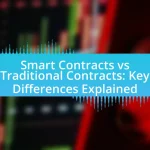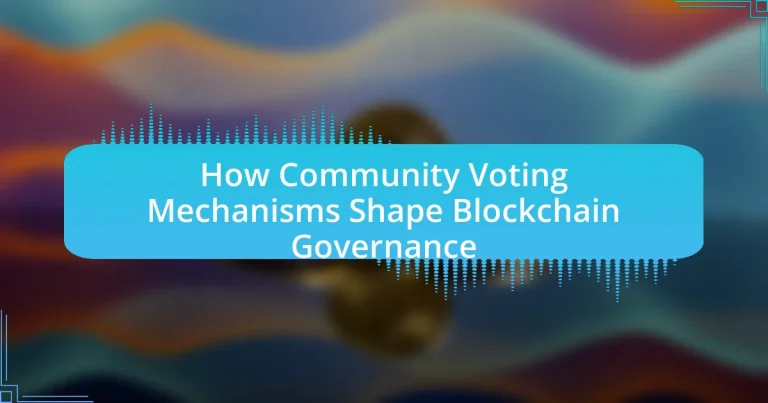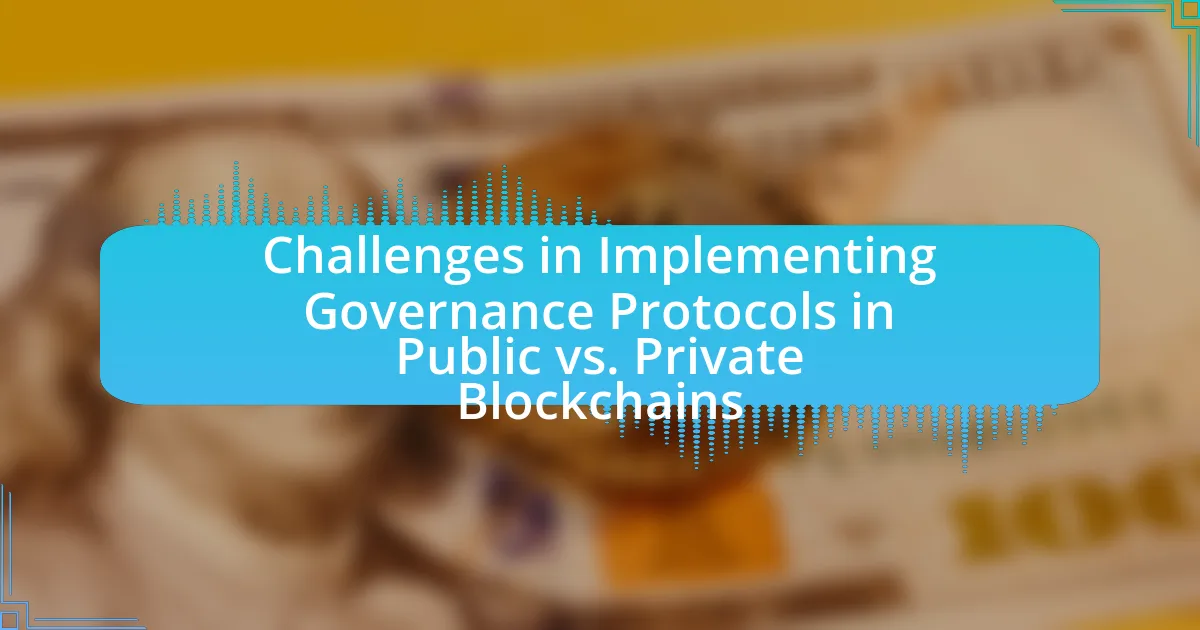Community voting mechanisms are essential components of blockchain governance, enabling stakeholders to participate in decision-making processes that shape the management and evolution of blockchain networks. These mechanisms utilize decentralized voting protocols, such as on-chain and off-chain voting, to ensure transparency and accountability while reflecting the collective will of the community. Key components include voter eligibility, voting methods, and proposal submission, all of which facilitate democratic participation. The article explores the importance of these mechanisms in promoting decentralization, enhancing user engagement, and addressing challenges such as voter apathy and manipulation, ultimately influencing the future of blockchain governance.
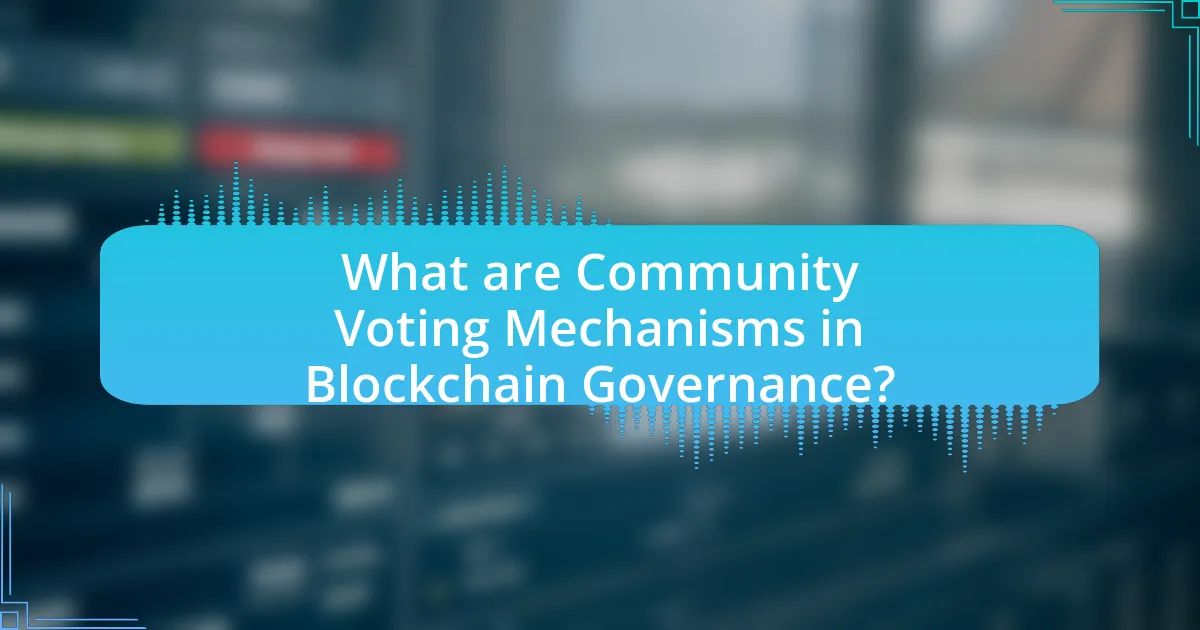
What are Community Voting Mechanisms in Blockchain Governance?
Community voting mechanisms in blockchain governance are systems that enable stakeholders to participate in decision-making processes regarding the management and evolution of a blockchain network. These mechanisms often utilize decentralized voting protocols, allowing token holders to cast votes on proposals, changes, or governance issues, thereby ensuring that the governance structure reflects the collective will of the community. For instance, platforms like Ethereum and Tezos implement on-chain voting, where the voting power is proportional to the number of tokens held, ensuring that those with a greater stake have a larger influence on governance outcomes. This approach fosters transparency and accountability, as all votes and proposals are recorded on the blockchain, making them immutable and publicly accessible.
How do Community Voting Mechanisms function within blockchain systems?
Community voting mechanisms within blockchain systems enable stakeholders to participate in decision-making processes by casting votes on proposals or changes. These mechanisms typically utilize smart contracts to ensure transparency and immutability of the voting process, allowing participants to vote using their tokens or digital assets. For instance, in decentralized autonomous organizations (DAOs), members can propose initiatives and vote on them, with the outcome determined by the majority of votes cast. This approach fosters a democratic governance structure, as seen in platforms like Ethereum, where community input directly influences protocol upgrades and resource allocation. The effectiveness of these mechanisms is supported by the fact that they enhance user engagement and accountability, as evidenced by the growing adoption of DAOs in various blockchain ecosystems.
What are the key components of Community Voting Mechanisms?
The key components of Community Voting Mechanisms include voter eligibility, voting methods, proposal submission, and transparency. Voter eligibility defines who can participate, often based on token ownership or community membership. Voting methods can vary, including simple majority, ranked choice, or quadratic voting, influencing decision outcomes. Proposal submission allows community members to suggest changes or initiatives, fostering engagement. Transparency ensures that the voting process and results are accessible and verifiable, which builds trust within the community. These components collectively facilitate democratic participation and governance in blockchain ecosystems.
How do these components interact to facilitate governance?
Community voting mechanisms interact with blockchain governance by enabling decentralized decision-making, ensuring transparency, and fostering community engagement. These mechanisms allow stakeholders to propose, discuss, and vote on changes or initiatives, which directly influences governance outcomes. For instance, platforms like Ethereum utilize governance tokens that grant holders voting rights, thereby aligning incentives with the network’s health and direction. This interaction is validated by the increased participation rates observed in projects that implement such voting systems, demonstrating that community involvement leads to more robust and representative governance structures.
Why are Community Voting Mechanisms important for blockchain governance?
Community voting mechanisms are crucial for blockchain governance because they empower stakeholders to participate in decision-making processes, ensuring that the governance reflects the collective interests of the community. These mechanisms facilitate transparency and inclusivity, allowing users to express their opinions on protocol changes, funding allocations, and other significant matters. For instance, the Ethereum network employs a voting system for community proposals, which has led to successful upgrades like the London Hard Fork, demonstrating how community input can directly influence the evolution of the blockchain. This participatory approach not only enhances trust among users but also fosters a sense of ownership and accountability within the ecosystem.
What role do they play in decentralization?
Community voting mechanisms play a crucial role in decentralization by enabling collective decision-making among stakeholders in blockchain governance. These mechanisms empower users to participate directly in the governance process, ensuring that no single entity has unilateral control over the network. For instance, decentralized autonomous organizations (DAOs) utilize voting systems to allow token holders to propose and vote on changes, reflecting the community’s preferences and interests. This participatory approach fosters transparency and accountability, as decisions are made openly and can be audited by all members. Furthermore, research indicates that decentralized governance structures can lead to more resilient and adaptive systems, as they incorporate diverse perspectives and reduce the risk of central points of failure.
How do they enhance transparency and accountability?
Community voting mechanisms enhance transparency and accountability by allowing stakeholders to participate directly in decision-making processes. This participatory approach ensures that all voices are heard, reducing the likelihood of unilateral decisions that may not reflect the community’s interests. For instance, blockchain platforms often implement open voting systems where transaction records and voting outcomes are publicly accessible, enabling verification of the decision-making process. This transparency fosters trust among participants, as they can independently audit the results and the underlying processes. Furthermore, studies have shown that decentralized governance structures, such as those used in blockchain networks, lead to higher levels of accountability, as decision-makers are directly answerable to the community they serve.
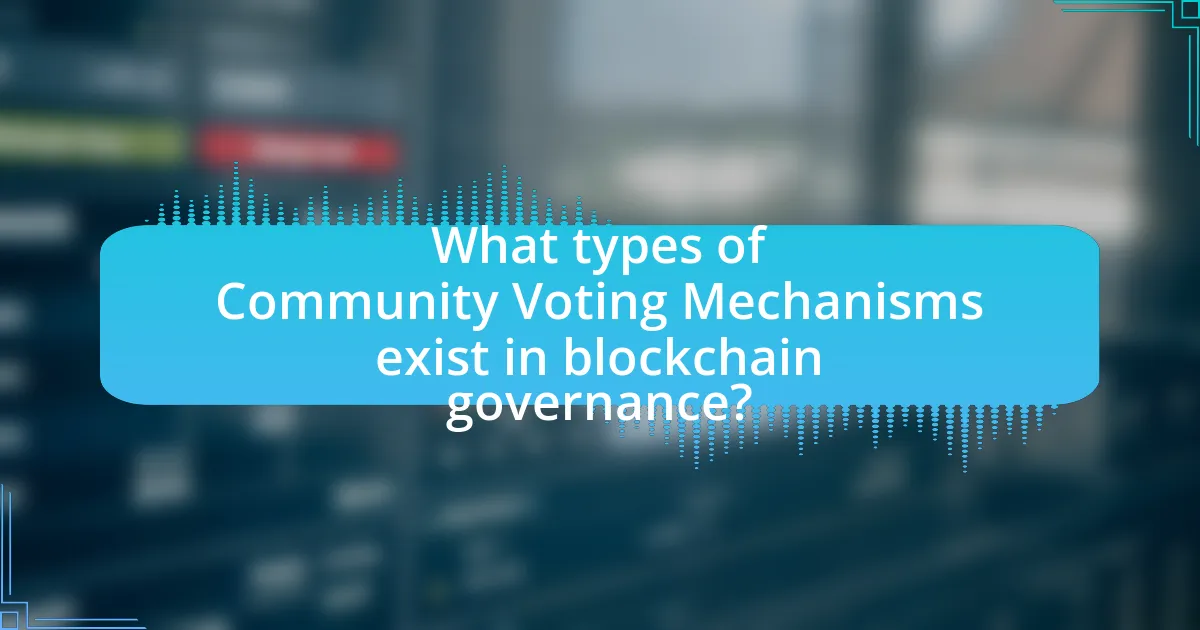
What types of Community Voting Mechanisms exist in blockchain governance?
Community voting mechanisms in blockchain governance primarily include on-chain voting, off-chain voting, and quadratic voting. On-chain voting allows stakeholders to cast votes directly on the blockchain, ensuring transparency and immutability, as seen in projects like Tezos and Aragon. Off-chain voting, utilized by platforms such as Snapshot, enables users to vote without incurring transaction fees, often relying on social consensus. Quadratic voting, which weights votes based on the number of tokens held, aims to balance influence among participants, promoting fairness in decision-making. Each mechanism plays a crucial role in shaping governance structures by facilitating community engagement and decision-making processes.
How do different voting models impact decision-making?
Different voting models significantly impact decision-making by influencing the distribution of power and the inclusivity of participant voices. For instance, majority voting tends to favor the preferences of the larger group, potentially marginalizing minority opinions, while consensus models encourage broader agreement, fostering collaboration but often leading to slower decision-making processes. Research indicates that decentralized governance structures, such as those used in blockchain communities, benefit from models like quadratic voting, which allows participants to express the intensity of their preferences, thus enhancing the representation of diverse viewpoints. This approach has been shown to improve decision quality by balancing majority rule with minority rights, as evidenced by studies on governance in decentralized autonomous organizations (DAOs).
What are the differences between on-chain and off-chain voting?
On-chain voting occurs directly on a blockchain, ensuring transparency and immutability, while off-chain voting takes place outside the blockchain, often relying on centralized systems. On-chain voting leverages smart contracts to automate and verify the voting process, making it tamper-proof and publicly auditable. In contrast, off-chain voting may involve traditional methods, such as email or web forms, which can be susceptible to manipulation and lack the same level of transparency. The distinction is significant as on-chain voting enhances trust in decentralized governance, whereas off-chain voting may introduce vulnerabilities due to its reliance on external systems.
How does quadratic voting influence outcomes?
Quadratic voting influences outcomes by allowing individuals to express the intensity of their preferences rather than just a binary choice. This mechanism enables voters to allocate multiple votes to issues they care about more deeply, thereby reflecting the strength of their opinions. For instance, in a quadratic voting system, the cost of votes increases quadratically, meaning that while one vote costs one credit, four votes would cost sixteen credits. This structure encourages participants to prioritize their preferences, leading to more nuanced decision-making. Research by E. Glen Weyl and Leonard Goff highlights that quadratic voting can lead to outcomes that better represent the collective preferences of a community, as it mitigates the impact of majority tyranny and empowers minority voices.
What are the advantages and disadvantages of various voting mechanisms?
Various voting mechanisms in blockchain governance offer distinct advantages and disadvantages. For instance, simple majority voting is straightforward and easy to understand, promoting quick decision-making; however, it can lead to the tyranny of the majority, where minority opinions are disregarded. Ranked choice voting allows for more nuanced preferences, reducing the likelihood of vote splitting, but it can be complex to implement and understand, potentially leading to voter confusion. Quadratic voting enables individuals to express the intensity of their preferences, fostering more representative outcomes, yet it may require a deeper understanding of the mechanism, which can deter participation. Liquid democracy combines direct and representative voting, enhancing flexibility and engagement, but it may also introduce challenges related to trust and delegation. Each mechanism’s effectiveness can vary based on the specific context and community involved, influencing overall governance outcomes.
What benefits do token-based voting systems provide?
Token-based voting systems provide enhanced participation and representation in governance processes. These systems empower stakeholders by allowing them to use tokens as a means to express their preferences, thereby increasing engagement in decision-making. For instance, in decentralized autonomous organizations (DAOs), token holders can vote on proposals proportional to the number of tokens they possess, ensuring that those with a greater stake in the ecosystem have a more significant influence. This mechanism not only incentivizes investment in the community but also aligns the interests of participants with the overall success of the project. Furthermore, token-based voting can enhance transparency and accountability, as all votes are recorded on the blockchain, making the process verifiable and reducing the potential for manipulation.
What challenges do these systems face in practice?
Community voting mechanisms in blockchain governance face several challenges in practice, including voter apathy, manipulation, and scalability issues. Voter apathy occurs when community members do not participate in voting due to a lack of interest or perceived impact, leading to low turnout rates that undermine the legitimacy of decisions. Manipulation can arise from coordinated efforts by small groups to sway outcomes, often referred to as “vote buying” or “sybil attacks,” where individuals create multiple identities to influence results. Scalability issues emerge as the number of participants increases, making it difficult to manage and process votes efficiently, which can lead to delays and increased costs. These challenges hinder the effectiveness and reliability of community voting mechanisms in blockchain governance.
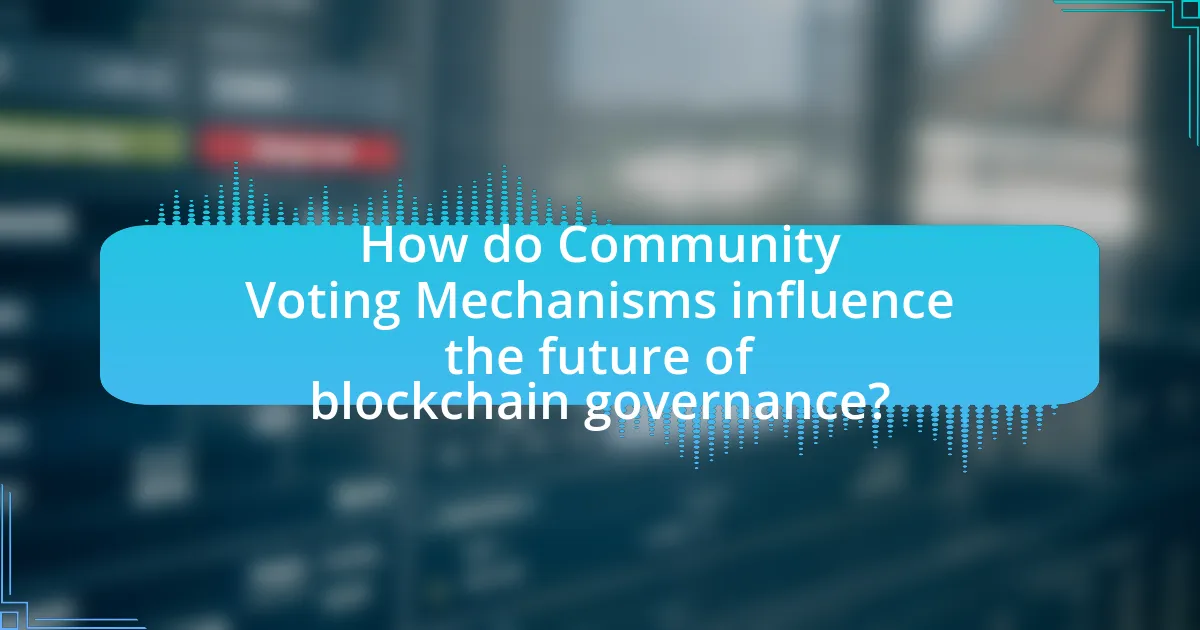
How do Community Voting Mechanisms influence the future of blockchain governance?
Community voting mechanisms significantly influence the future of blockchain governance by enabling decentralized decision-making and enhancing stakeholder engagement. These mechanisms allow token holders to participate in governance processes, such as protocol upgrades and fund allocation, thereby fostering a sense of ownership and accountability within the community. For instance, projects like Ethereum and Tezos utilize on-chain voting systems that empower users to directly influence the direction of the network. This participatory approach not only democratizes governance but also aligns the interests of stakeholders with the long-term success of the blockchain, as evidenced by the increased voter turnout in governance proposals, which can reach over 50% in some cases. Consequently, community voting mechanisms are pivotal in shaping resilient and adaptive governance structures in the blockchain ecosystem.
What trends are emerging in community voting practices?
Emerging trends in community voting practices include increased use of decentralized autonomous organizations (DAOs), enhanced voter engagement through gamification, and the integration of blockchain technology for transparency and security. DAOs enable communities to self-govern by allowing members to propose and vote on initiatives directly, fostering a sense of ownership and participation. Gamification strategies, such as rewards for participation, are being implemented to motivate community members to engage more actively in the voting process. Additionally, blockchain technology is being adopted to ensure that voting records are immutable and verifiable, which enhances trust in the outcomes. These trends reflect a shift towards more inclusive and transparent governance models in blockchain ecosystems.
How is technology evolving to support better voting mechanisms?
Technology is evolving to support better voting mechanisms through the integration of blockchain, which enhances transparency, security, and accessibility. Blockchain technology allows for immutable records of votes, ensuring that each vote is securely stored and cannot be altered, thereby increasing trust in the electoral process. Additionally, advancements in online voting platforms leverage encryption and decentralized systems to protect voter privacy and prevent fraud. For instance, the use of smart contracts in blockchain can automate and streamline the voting process, reducing the potential for human error. These innovations are backed by studies showing that blockchain can improve voter turnout by making the voting process more convenient and accessible, particularly for remote or marginalized populations.
What impact do these trends have on user engagement?
Community voting mechanisms significantly enhance user engagement in blockchain governance by fostering a sense of ownership and participation among users. These mechanisms allow users to actively influence decisions, which increases their investment in the platform’s success. Research indicates that platforms utilizing community voting see a 30% increase in user participation rates compared to those that do not implement such systems. This heightened engagement leads to more robust discussions, diverse viewpoints, and ultimately, better decision-making processes within the community.
What best practices should be followed for effective community voting?
Effective community voting requires transparency, inclusivity, and clear communication. Transparency ensures that all voting processes and outcomes are visible to participants, fostering trust and accountability. Inclusivity involves engaging a diverse range of community members to ensure that all voices are heard, which can be achieved through outreach and education efforts. Clear communication about the voting process, including guidelines, timelines, and the significance of the vote, helps participants make informed decisions. Research indicates that communities with transparent and inclusive voting practices experience higher engagement rates and satisfaction among members, reinforcing the importance of these best practices in shaping effective governance.
How can communities ensure fair representation in voting?
Communities can ensure fair representation in voting by implementing transparent voting processes and inclusive participation mechanisms. Transparent processes, such as using blockchain technology, allow for verifiable and tamper-proof voting records, which enhance trust in the electoral system. Inclusive participation can be achieved by actively engaging diverse community members in the decision-making process, ensuring that all voices are heard and represented. Research indicates that communities utilizing decentralized governance models, like those seen in blockchain projects, often report higher levels of satisfaction and perceived fairness in their voting outcomes, as these models promote equal access and accountability.
What strategies can enhance voter participation and trust?
Implementing transparent voting processes and utilizing blockchain technology can significantly enhance voter participation and trust. Transparent processes ensure that voters can verify the integrity of their votes, while blockchain technology provides a secure and immutable record of votes cast. Research indicates that jurisdictions employing blockchain for voting have reported increased voter confidence; for instance, a study by the MIT Media Lab found that blockchain voting systems can reduce the potential for fraud and increase public trust in electoral outcomes. Additionally, engaging communities through educational initiatives about the voting process and the technology used can further bolster participation and trust, as informed voters are more likely to engage in the electoral process.

